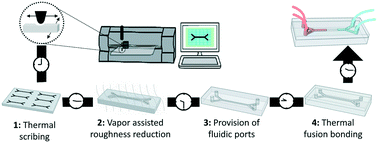Thermal scribing to prototype plastic microfluidic devices, applied to study the formation of neutrophil extracellular traps†
Abstract
Innovation in microfluidics-based biological research has been aided by the growing accessibility of versatile microscale fabrication techniques, particularly in rapid prototyping of elastomeric polydimethylsiloxane (PDMS) based devices. However, the use of PDMS presents considerable and often unexpected limitations, particularly in interpreting and validating biological data. To rapidly prototype microfluidic culture systems in conventional plastics commonly used in cell culture, we developed ‘thermal scribing’, a one-step micromachining technique in which thermoplastics are locally patterned by a heated tip, moving in user-controlled patterns. To demonstrate and study the thermal scribing process, we modified an inexpensive desktop hobby craft cutter with a soldering iron to scribe micropatterns on polystyrene substrates. The thermal scribing technique is useful for creating a variety of channel profiles and geometries, which cannot be readily achieved using other microfabrication approaches. The entire fabrication process, including post-processing operations needed to fabricate devices, can be completed within a few hours without the need for skilled engineering expertise or expensive equipment. We apply this technique to demonstrate that induction of functional neutrophil extracellular traps (NETs) can be significantly enhanced over previous studies, when experiments are conducted in microfluidic channels prototyped in an appropriate material. These results ultimately inform the design of neutrophil culture systems and suggest that the inherent ability of neutrophils to form NETs may have been significantly under-reported.

- This article is part of the themed collection: CSC100: Celebrating Canadian Chemistry


 Please wait while we load your content...
Please wait while we load your content...